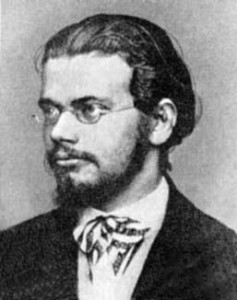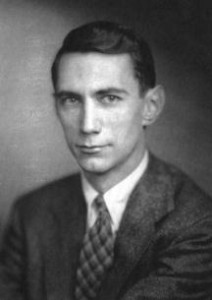
Recently a friend of mine asked about finding a good reason to explain the presence of the Boltzmann-Shannon entropy here and there in mathematics. Well, a vague answer is to simply say that the logarithm is already in many places, waiting for a nice interpretation. A bit less vaguely, here are some concrete fundamental formulas involving the Boltzmann-Shannon entropy \( {\mathcal{S}} \) also denoted \( {-H} \).
Combinatorics. If \( {n=n_1+\cdots+n_r} \) and \( {\lim_{n\rightarrow\infty}\frac{(n_1,\ldots,n_r)}{n}=(p_1,\ldots,p_r)} \) then
\[ \frac{1}{n}\log\binom{n}{n_1,\ldots,n_r} =\frac{1}{n}\log\frac{n!}{n_1!\cdots n_r!} \underset{n\rightarrow\infty}{\longrightarrow} -\sum_{k=1}^r p_k\log(p_k)=:\mathcal{S}(p_1,\ldots,p_r). \]
Also \( {\binom{n}{n_1,\ldots,n_r}\approx e^{-nH(p_1,\ldots,p_r)}} \) when \( {n\gg1} \) and \( {\frac{(n_1,\ldots,n_r)}{n}\approx (p_1,\ldots,p_r)} \). Wonderful!
Volumetrics. In terms of microstates and macrostate we also have
\[ \inf_{\varepsilon>0} \varlimsup_{n\rightarrow\infty} \frac{1}{n} \log\left| \left\{ f:\{1,\ldots,n\}\rightarrow\{1,\ldots,r\}: \max_{1\leq k\leq r}\left|\frac{f^{-1}(k)}{n}-p_k\right|<\varepsilon \right\}\right| =\mathcal{S}(p_1,\ldots,p_r). \]
This formula can be related to the Sanov Large Deviations Principle, some sort of refinement of the strong Law of Large Numbers.
Maximization. If \( {\displaystyle\int\!V(x)\,f(x)\,dx=\int\!V(x)f_\beta(x)\,dx} \) with \( {f_\beta(x)=\frac{e^{-\beta V(x)}}{Z_\beta}} \) then
\[ \mathcal{S}(f_\beta) - \mathcal{S}(f) =\int\!\frac{f}{f_\beta}\log\frac{f}{f_\beta}f_\beta\,dx \geq\left(\int\!\frac{f}{f_\beta}f_\beta\,dx\right)\log\left(\int\!\frac{f}{f_\beta}f_\beta\,dx\right)=0. \]
This formula plays an important role in statistical physics and in Bayesian statistics.
Legendre transform is log-Laplace. If \( {\mu} \) and \( {\nu} \) are probability measures then
\[ \sup_{\substack{g\geq0\\\int g\mathrm{d}\mu=1}} \Bigr\{\int fg\mathrm{d}\mu-\int f\log f\mathrm{d}\mu\Bigr\} =\log\int\mathrm{e}^f\mathrm{d}\mu \quad\text{where}\quad f:=\frac{\mathrm{d}\nu}{\mathrm{d}\mu}. \]
and the reverse identity by convex duality
\[ \int f\log f\mathrm{d}\mu =\sup_{\int g\mathrm{d}\mu=1} \Bigr\{\int fg\mathrm{d}\mu-\log\int\mathrm{e}^g\mathrm{d}\mu\Bigr\}. \]
Involved notably in large deviations theory and functional inequalities.
Likelihood. If \( {X_1,X_2,\ldots} \) are i.i.d. r.v. on \( {\mathbb{R}^d} \) with density \( {f} \) then
\[ L(f;X_1,\ldots,X_n) =\frac{1}{n}\log(f(X_1,\ldots,X_n)) \overset{a.s.}{\underset{n\rightarrow\infty}{\longrightarrow}} \int\!f\log(f)\,dx=:-\mathcal{S}(f). \]
This formula allows to reinterpret the maximum likelihood estimator as a minimum contrast estimator for the Kullback-Leibler divergence or relative entropy. It is also at the heart of Shannon coding theorems in information theory.
\( {L^p} \) norms. If \( {f\geq0} \) then
\[ \partial_{p=1}\left\Vert f\right\Vert_p^p =\partial_{p=1}\int\!e^{p\log(f)}\,dx =\int\!f\log(f)\,dx =-\mathcal{S}(f). \]
This formula is at the heart of a famous theorem of Leonard Gross which relates the hypercontractivity of ergodic Markov semigroups with a logarithmic Sobolev inequality for the invariant measure of the semigroup.
Fisher information. If \( {\partial_t f_t(x)=\Delta f_t(x)} \) then by integration by parts
\[ \partial_t\mathcal{S}(f_t) =-\int\!\log(f_t)\,\Delta f_t\,dx =\int\!\frac{\left|\nabla f_t\right|^2}{f_t}\,dx =\mathcal{F}(f_t). \]
This formula, attribued to de Bruijn, is at the heart of the analysis and geometry of heat kernels, diffusion processes, and gradient flows in partial differential equations.

L'entropie chez Honoré de Balzac avant Rudolf Clausius (référence communiquée par Ivan Gentil) :
Extinction du mal et entropie dans les « contes et romans philosophiques »
Max Milner, L'Année balzacienne 2006/1 (n° 7), pages 7 à 16.